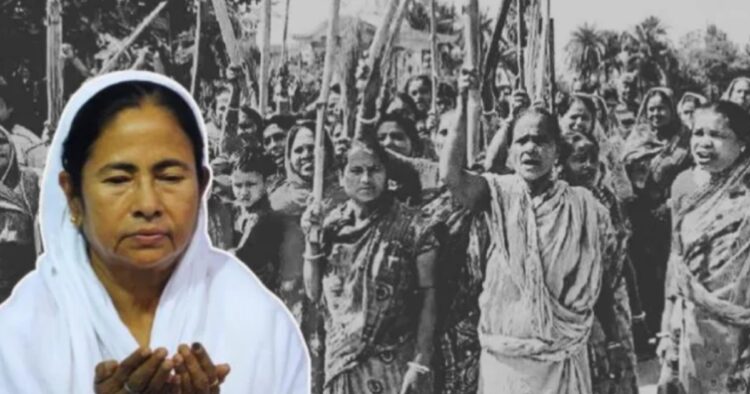Another horrifying example of how a false rumor can destroy lives, homes, and harmony—what happened in Murshidabad is not the first, and unfortunately, it’s not the last.
A wave of violence erupted in Murshidabad district of West Bengal on Friday after a rumor spread like wildfire, claiming that a protester had died due to police action during a demonstration against the Waqf (Amendment) Act. The situation quickly spiraled out of control as a furious mob took to the streets, launching attacks on Hindu communities and police forces.
Several areas including Jalpaiguri and North 24 Parganas, such as Achintola, also witnessed similar unrest. Angry crowds set fire to shops, torched police vans, and blocked roads. Stones were pelted at police and civilians, while Hindu homes and properties were deliberately targeted. Vehicles were burned one after another. According to police, over 110 people have been arrested so far from different parts of the Murshidabad district, including 70 from Suti and 41 from Samserganj.
Authorities imposed Section 144 in sensitive areas and suspended internet services to prevent the spread of further rumors. Despite strict patrolling and appeals for peace, tension still looms. A teenage boy injured in police firing has been shifted to Kolkata for treatment.
Opposition leaders like Suvendu Adhikari slammed the Mamata Banerjee government for its silence and inaction. He accused radical groups of deliberately planning the violence under the cover of protests, calling it a direct attack on democracy and social harmony. He demanded strong legal action against those responsible for creating fear and chaos.
Just like Murshidabad, Nagpur in Maharashtra too faced a brutal wave of violence recently. A peaceful protest by the VHP and Bajrang Dal against the glorification of Aurangzeb turned violent after a false rumor claimed that a religious poster containing Quranic verses was burned during the protest. The result? Hindu homes and vehicles were attacked, over 40 vehicles torched, and 32 police personnel injured—three of them senior officers.
Police acted quickly and arrested over 84 rioters. However, the damage was already done. Witnesses said the attacks were not random, but targeted and deliberate. Once again, the spark was a baseless rumor.
In Kochila, a man named Iqbal Hussain reportedly planted a torn page from the Quran in a Durga Puja pandal and spread a false claim that Hindus had insulted the holy book. This planned provocation triggered a series of violent attacks in areas like Champur and Cockbazar. Over 150 Hindu families were attacked, and hundreds of temples and pandals were destroyed.
Despite rising tensions and intelligence warnings, authorities failed to act in time. The violence looked like a well-coordinated plot to instill fear among Hindu communities.
This dangerous pattern isn’t limited to India. In 2012, Cox’s Bazar in Bangladesh witnessed brutal violence when over 25,000 people attacked Buddhist homes and temples following a false claim that a Buddhist youth desecrated the Quran. More than 50 homes and 12 temples were burned in a single night.
Ironically, just before the attack, then PM Sheikh Hasina had launched a project to preserve Buddhist heritage in the same region. Investigations were started, but justice for the Buddhist victims remains slow and insufficient.
In 2013, another false rumor in Keshpur led to a massive mob of 10,000 people attacking Hindu villages after a Muslim cleric was allegedly shot. Miscreants falsely claimed that Hindus were behind the attack. Soon, acid bombs, kerosene, and fire were unleashed on over 200 Hindu homes. Thousands of families had to flee their villages, and entire communities were displaced overnight.
One of the darkest chapters in Indian history was written in Moradabad, Uttar Pradesh, in 1980. A false claim that Hindus had released a pig into a Muslim prayer ground during Eid triggered large-scale violence. Mobs went berserk, resulting in 83 deaths and hundreds injured.
Recently, a judicial report confirmed that the riot was not a sudden communal conflict but a politically motivated and planned massacre orchestrated by Muslim League leaders for their own gains.
From Murshidabad to Nagpur, Kochila to Keshpur, and even across borders into Bangladesh, these incidents show a chilling trend. False rumors, often spread deliberately, have become dangerous weapons in the hands of radical elements. Innocent lives are destroyed, communities are shattered, and harmony is replaced with hatred.
What happened in Murshidabad is not just another isolated riot. It is part of a continuing cycle of misinformation-fueled violence that needs urgent national attention. The question remains: How many more Murshidabads will it take before authorities take firm action against those who manufacture hate with lies?

















Comments